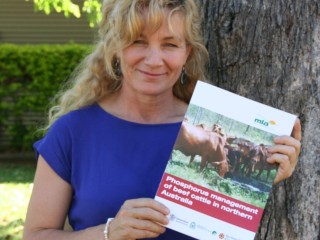 Northern cattle producers, including those who benefited from good storm rain last week, are being urged to plan for forthcoming dry season cattle requirements now.
Northern cattle producers, including those who benefited from good storm rain last week, are being urged to plan for forthcoming dry season cattle requirements now.
Private livestock consultant Désirée Jackson, Désirée Jackson Livestock Management Services, Longreach, says the message applies equally to producers who have had a good or bad wet season.
Producers who have received good rain over the wet season can still face expensive feeding programs over the dry.
And, importantly, for producers who missed out and have no pasture left and for whom available cash is tight, there were still options.
Where producers have had a good wet season, feed will still lose its nutritive value as it matures during the dry season, regardless of the amount of feed available.
Breeders heavy in calf or cows with calves at foot will also eventually require an energy supplement.
Ms Jackson advises producers to do a forage budget now to determine how long available pasture will last with the cattle they are currently holding.
Mobs that can be sold now should be identified and segregated so they can be preferentially fed or will be ready to go on a truck as required.
Undertaking a diet quality analysis – F.NIRS to determine the diet quality – was also important now to provide a clear picture of whether whether cattle are meeting their nutritional requirements or not, which allows producers to take action before cattle start losing weight.
This knowledge allows producers to time the introduction of a supplement properly, and to formulate the correct supplement, which will safeguard against early onset of weight loss and may stretch out the length of time they can feed a urea-based lick before they need to upgrade to an energy supplement.
Importantly, for producers with no pasture left and tight cash availability, there were still options.
Under these circumstances Ms Jackson recommends:
1. If breeders are poor and the cost of feeding poddy calves is prohibitive, calves should be weaned. There are plenty of people willing to take on poddies who are not from the land, as a hobby or interest;
2. Feeding hay to cattle because there is no pasture should only be a short-term measure to rehabilitate stock until they are fit for travel. If hay has to be fed to cattle to keep them alive, then this should only be a short-term option with the view to remove cattle from the property.
3. Many arrangements can be negotiated with people who are more cash positive, to feed cattle in exchange for a proportion of calves or purchase of surplus cattle, or those breeders that are the greatest survival risk in terms of their high nutritional requirements.
Considerations when planning supplementation
Many energy supplements have been depleted this year or are in short supply. Forward contracts are already being arranged for the next whole cottonseed harvest and it will be a while before an abundant supply of molasses is available – two energy supplements heavily relied upon in northern Australia.
Here are three considerations Ms Jackson recommends when planning supplementation:
1. If it is likely that you will need to feed an energy supplement over the dry season, work out a worst case scenario for how long and how much you will need to feed and what it will cost on today’s market. For example, a trailer of whole cottonseed weighing approximately 24 tonnes will last a paddock of 250 breeders 3 months (90 days) fed at a rate of 1 kg/head/day. It doesn’t take long to get through it all.
2. Stay abreast of commodity prices. Don’t leave purchases to the last minute. In March 2013 whole cottonseed was selling for as cheap as $170/tonne ex-gin and yet many held off until later in the year to purchase it for $400 – $500/tonne.
3. If you haven’t got the financial resources to feed energy supplements for another year, consider your options:
a. Identify in what order groups of cattle will be sold and work on a contingency plan – take into account which animals have the highest nutritional requirements and , which are the biggest drought risk and which animals are surplus to the current program, without depleting next year’s cash flow..
b. On the preg test muster, identify breeders that are likely to calve during the dry season and consider selling them – they are a liability if they are held and good cash income they are sold
c. Wean early – it is always cheaper to feed an energy supplement to a weaner than a wet cow. It is also more effective.
“There is always a concern that cattle prices will be high when people want to buy back. No where on any graph of cattle sold within Australia has a peak in prices not been followed by a trough. Opportunities for purchasing become available. Timing is everything.” In the meantime, it will give paddocks the necessary time to recover.
Former Queensland Department of Agriculture, Fisheries ad Forestry beef scientist and extension officer Désirée Jackson now runs a private livestock consultancy based in Longreach. She can be contacted on (07) 4658 3254, mobile 0409 062 629 or email desireejackson@bigpond.com



HAVE YOUR SAY